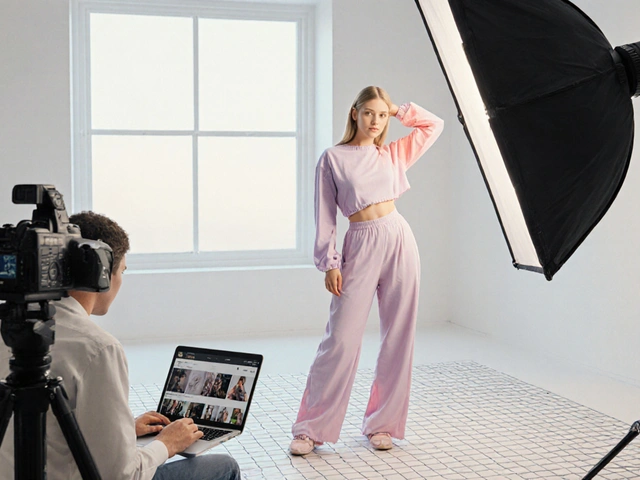Want to turn your Instagram feed into a reliable income stream? Being an Instagram Model is more than posting pretty pictures-it’s a full‑on business that requires strategy, contracts, and a solid financial plan. Below you’ll find the exact steps, tools, and pitfalls to watch out for so you can start earning consistently.
1. Craft a Portfolio That Sells
First impressions matter. Your grid should read like a mini‑catalog, not a random diary. Choose a consistent visual style-whether it’s high‑contrast street fashion or soft pastel lifestyle shots-and stick to it. Use a professional photographer for at least 10 high‑resolution images that showcase different outfits, poses, and lighting conditions. When you upload them, add a brief Media Kit description in the caption: who you are, follower count, engagement rate, and the type of brand you’re best suited for.
2. Find Brand Partnerships the Right Way
Brands look for three things: reach, relevance, and reliability. Start by creating a list of brands that match your niche-think swimwear for a beach aesthetic or activewear for fitness‑focused content. Then reach out with a concise pitch email that includes:
- Your follower count and average Engagement Rate (likes + comments ÷ followers × 100%).
- Link to your Media Kit.
- Specific ideas for the collaboration (e.g., an Sponsored Post series, Instagram Reels, or giveaway).
Platforms like Influencity, Tribe and BrandSnob also host databases where brands post campaign briefings you can apply to directly.
3. Price Your Work and Protect Yourself with Contracts
Many newcomers undercharge, thinking low prices will attract more brand deals. In reality, a well‑structured contract and clear pricing model build credibility and yield higher long‑term earnings. Here’s a quick pricing cheat‑sheet:
- Sponsored Post: $150-$300 per 10k followers (mid‑tier niche) or $300-$600 for high‑engagement accounts.
- Story Series (3‑5 frames): 60% of the post rate.
- Affiliate Marketing (commission‑based): 5%-15% of sales generated via your unique link.
- Merchandise or product line: 20%-40% profit margin after production costs.
Always include these clauses in every contract:
- Deliverables (number of posts, formats, deadlines).
- Payment terms (50% upfront, 50% on delivery).
- Usage rights (how long the brand can reuse your content).
- Disclosure requirements (clear #ad or #sponsored tag).
Use a simple template from the Influencer Marketing Hub, then customize for each brand.
4. Diversify Revenue Streams
Relying only on one brand deal per month is risky. Successful Instagram models mix several income sources. Below is a comparison of the most common streams.
| Stream | Typical Earnings | Effort Required | Scalability |
|---|---|---|---|
| Sponsored Post | $150-$600 per post | Medium - content creation & brand approval | High - can scale with follower growth |
| Affiliate Marketing | 5%-15% of sales | Low - add trackable links | Very High - passive income |
| Merchandise | $20-$60 per item | High - design, inventory, fulfillment | Medium - depends on brand loyalty |
| Digital Courses/Guides | $30-$200 per sale | High - content creation, hosting | High - evergreen product |
| Live Sessions/Paid Subscriptions | $5-$20 per subscriber | Medium - regular live content | Medium - retention matters |
Mixing at least three of these streams usually stabilizes monthly cash flow and protects you from seasonal brand budget cuts.
5. Keep Your Finances Clean and Tax‑Ready
Instagram earnings are taxable in most jurisdictions. Treat your influencer work like a small business:
- Open a separate bank account for revenue.
- Track every payment-use free tools like Wave or QuickBooks Self‑Employed.
- Save 30% of each payment for taxes; adjust based on your local tax rate.
- Claim legitimate expenses: camera gear, editing software, travel for shoots, home‑office portion of rent, and even a portion of your phone bill.
Hire a CPA who understands digital creators. They can help you with quarterly estimated taxes and ensure you’re compliant with disclosure regulations from the FTC.
6. Legal & Ethical Must‑Know
Failing to disclose paid partnerships can lead to hefty fines and lost trust. The FTC requires you to make the relationship clear with tags like #ad, #sponsored, or #paid. Additionally, watch out for:
- Copyrighted music in Reels-use royalty‑free tracks or Instagram’s library.
- Model releases for any third‑party locations or product shots.
- Age restrictions: most brand contracts require you to be 18 + or have parental consent.
Having a basic legal checklist ready reduces last‑minute surprises when a brand asks for a contract.

7. Growth Hacks & Tools You Can’t Ignore
Automation and analytics are your secret weapons. Here are the top tools used by successful Instagram models:
- Later - schedule posts, plan a visual content calendar, and preview the feed.
- Iconosquare - deep dive into engagement metrics and best posting times.
- Canva Pro - create story templates and highlight covers in minutes.
- Trackyard - generate unique affiliate links that auto‑track clicks and sales.
- Google Drive - keep contracts, media kits, and invoices organized in shared folders.
Combine these tools with a disciplined Content Calendar. Plan at least two weeks ahead, slot in sponsored posts, organic content, and behind‑the‑scenes stories. Consistency drives algorithmic favor and keeps brands confident you’ll meet deadlines.
8. Common Pitfalls and How to Avoid Them
Even seasoned models slip up. Spot the red flags early:
- Chasing vanity metrics. Likes are nice, but brands care about conversions. Focus on click‑through rates and sales generated.
- Over‑promising. Never guarantee a sales figure you can’t control. Use language like “will showcase” instead of “will drive”.
- Ignoring audience feedback. If followers say a product feels out‑of‑place, adjust before the next pitch.
- Neglecting personal branding. Your Instagram should reflect who you are, not just what brands want. Authenticity translates into higher trust and better rates.
By keeping these lessons in mind, you’ll stay profitable and enjoy the creative freedom that drew you to Instagram in the first place.
Quick Takeaways
- Build a cohesive, high‑quality portfolio and a downloadable media kit.
- Pitch brands with clear numbers, ideas, and a professional contract.
- Mix sponsored posts, affiliate links, merch, and digital products for steady cash flow.
- Track every dollar, set aside tax money, and claim legitimate expenses.
- Always disclose paid partnerships and keep contracts organized.
How much can an Instagram model realistically earn per month?
Earnings vary widely, but a mid‑tier model (50k‑150k followers, 3%-5% engagement) can pull $2,000-$5,000 from sponsored posts, $500-$1,000 from affiliate commissions, and $300-$700 from merch sales each month. Combining these streams often lands you in the $3,000-$7,000 range.
Do I need a manager or agent to get brand deals?
Not necessarily. Many creators negotiate directly using email or platforms like Tribe. However, as your inbox fills, a manager can handle contracts, rate negotiations, and protect you from unfavorable terms.
What legal disclosures are required for paid posts?
The FTC mandates clear, conspicuous disclosure. Use #ad, #sponsored, or #paid in the first line of the caption. If you use Instagram’s paid partnership tag, the disclosure is automatically visible.
How do I set my rates without scaring brands away?
Start with industry benchmarks (e.g., $150 per 10k followers for a single post) and adjust based on engagement and niche demand. Offer tiered packages-basic post, post + story, post + story + reel-to give brands flexibility.
Can I monetize my account if I’m under 18?
Most brands require creators to be 18 or have parental consent. If you’re underage, involve a parent or guardian in the contract and payment process to stay compliant.






October 22, 2025 AT 15:43
Gabby Eniola
I love how the guide breaks down the portfolio step. It’s super useful to have a media kit ready from day one. Consistent aesthetic really does attract the right brands. Also, tracking engagement in a simple spreadsheet keeps everything clear.
October 23, 2025 AT 00:03
Tony Stutz
Listen, they don’t tell you that every brand wants you to be hooked up with a secret agenda. The platforms like Influencity are just a front for data collection. You’re basically signing away your privacy for a few hundred bucks. I’ve seen creators lose control when they sign contracts without reading the fine print. The whole “tax‑ready” advice is a trap to keep you in the system. They want you to think you’re a business, but you’re a pawn. Keep your bank account separate and never give your real address to strangers. Stay alert and protect your content at all costs.
October 23, 2025 AT 08:23
Madi Vachon
Patriotic creators should prioritize domestic brands that amplify national pride. Leveraging localized hashtags yields higher CPM within our market sphere. The guide’s pricing matrix is a baseline; upscale it for home‑grown campaigns to reflect premium exposure. Remember, brand equity is a strategic asset that must be quantified in ROI metrics. Negotiate usage rights aggressively to prevent foreign exploitation of your visual capital. Diversify streams but keep the core focus on merch that showcases native craftsmanship. This approach fortifies the ecosystem and safeguards cultural integrity.
October 23, 2025 AT 16:43
Sunny Kumar
OMG!!! I can’t even with these “secret agenda” vibes-so many hidden cameras everywhere!!! The algoriddm is rigged, & they’re feeding us lies!! I’m telling ya, even the “tax‑ready” tip is a trap set by the elite to keep us chained!!! You gotta stay woke, fam!!!
October 24, 2025 AT 01:03
Tracy Riley
The epistemological underpinnings of influencer economics reveal a paradox wherein the ostensible democratization of commerce simultaneously entrenches hierarchical commodification. By invoking the lexicon of entrepreneurship, the guide tacitly endorses a neoliberal narrative that valorizes individual agency while obfuscating systemic inequities. One must interrogate the purported “portfolio” as a curated simulacrum, a hyperreal tableau that perpetuates aesthetic conformity under the guise of brand alignment. The recommended pricing schema, albeit ostensibly data‑driven, rests upon an assumed linear correlation between follower count and intrinsic value-a hypothesis that neglects the stochastic nature of engagement quality. Moreover, the emphasis on diversification through merchandise and digital courses presupposes a monolithic consumer base eager to consume ancillary products, thereby reinforcing the culture of perpetual consumption. It is incumbent upon the discerning creator to juxtapose these prescriptive tactics with a critical analysis of one’s own positionality within the digital agora. The fiscal guidance, while pragmatic, normalizes the absorption of capitalist tax structures without prompting reflection on alternative economic models. In this vein, a dialectical approach to revenue streams-balancing monetization with ethical stewardship-offers a more holistic paradigm. Consequently, the guide’s utility is contingent upon the reader’s capacity to synthesize its procedural directives with a broader philosophical framework. Ultimately, the synthesis of aesthetic rigor, contractual acumen, and fiscal discipline can engender a sustainable praxis, provided it is anchored in reflexive consciousness rather than blind emulation. Furthermore, the cultivation of a personal brand narrative should resist the homogenizing pressures of algorithmic optimization, lest authenticity be sacrificed at the altar of virality. A nuanced understanding of audience psychographics enables creators to tailor content that resonates beyond superficial metrics, fostering genuine community bonds. Finally, embracing interdisciplinary collaborations-anchored in art, technology, and sociology-can catalyze innovative monetization pathways that transcend conventional influencer paradigms. In sum, the strategic deployment of influencer capital must be interrogated through a lens of ethical responsibility, ensuring that profit does not eclipse principle. Only then can the Instagram model transcend mere commodification and embody a conduit for cultural dialogue.
October 24, 2025 AT 09:23
Mark Ghobril
Great rundown, especially the tip about keeping a separate bank account for earnings. It really helps when tax time rolls around. I’ve started using Wave for tracking, and it’s been a game changer. Staying organized early saves a lot of headaches later.
October 24, 2025 AT 17:43
Adam Williams
Absolutely, Mark! 🎉 Keeping finances tidy is the unsung hero of influencer success. 💪 Also, those content calendars you mentioned are pure gold – they keep the feed fresh and brands happy. 🌟
October 25, 2025 AT 02:03
Jess Felty
The whole “content calendar” is just a way to monitor our every move. They want us on a schedule so they can predict our influence and harvest data. Never let them box you in with a timeline; fight the system.
October 25, 2025 AT 10:23
Kathy ROBLIN
What a rollercoaster of advice!